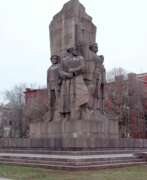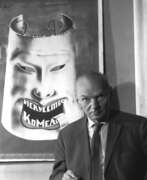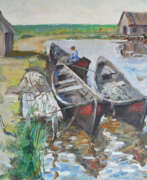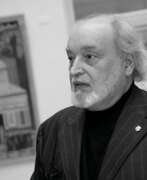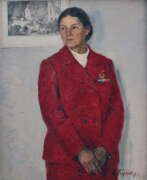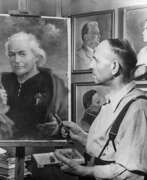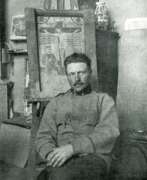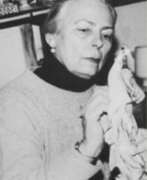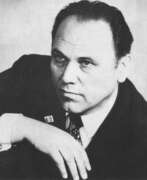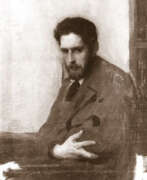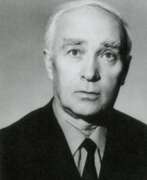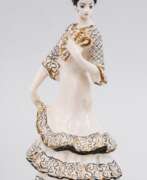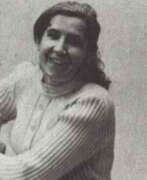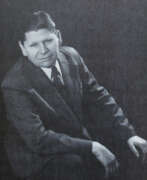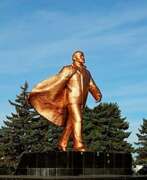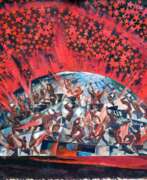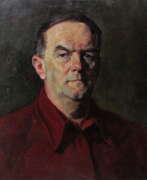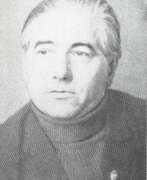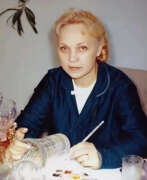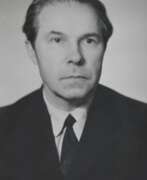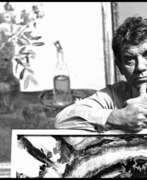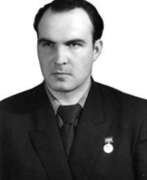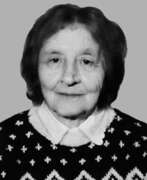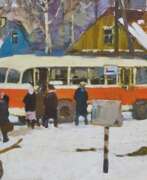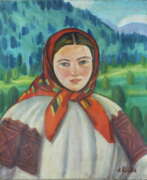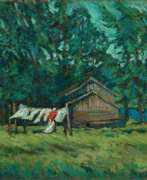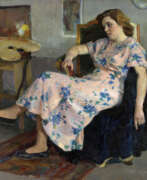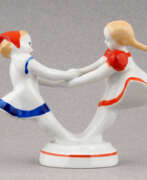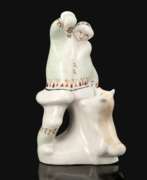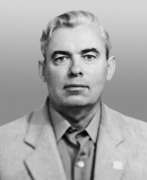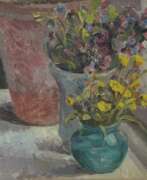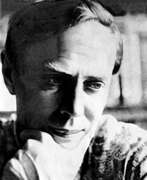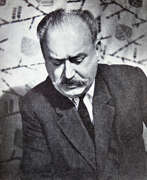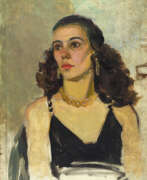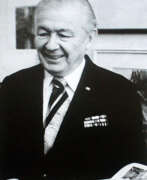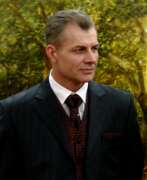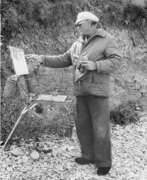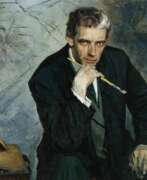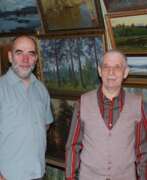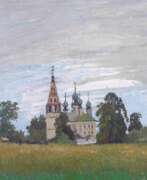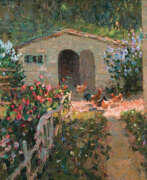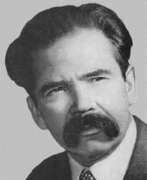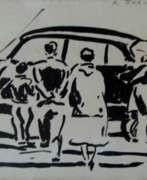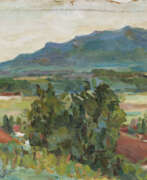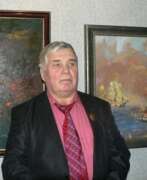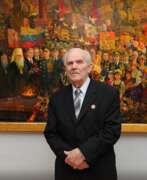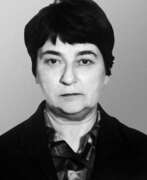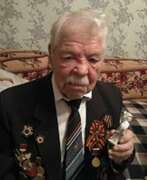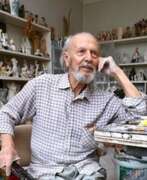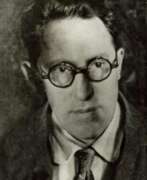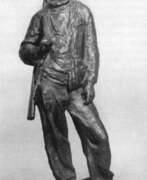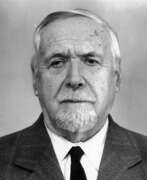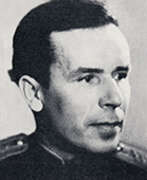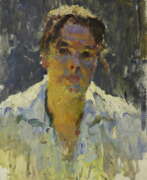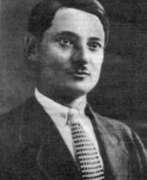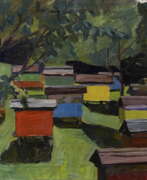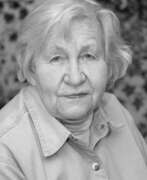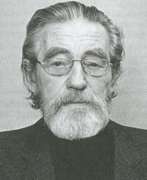Ukraine Socialist realism
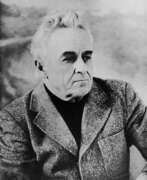

Alexander Grigorievich Maksymenko (Russian: Александр Григорьевич Максименко) was a Soviet and Ukrainian painter of the second half of the twentieth and early twenty-first centuries. He is known as a painter, graphic artist, watercolorist, and art historian.
Alexander Maksymenko worked in the genres of still life, landscape, portrait, as well as in genre painting. His genre works cover themes of collective farm life, including "Masters of the Land" and "Innovators of Collective Farm Fields". For the latter work he received the Stalin Prize. The master actively participated in exhibitions in Ukraine and abroad. His works are in the National Art Museum of Ukraine, the Museum of the History of Ukraine in World War II, as well as in other art museums and private collections.
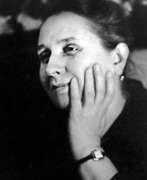

Taisia Kirillovna Afonina (Russian: Таисия Кирилловна Афонина) was a Soviet artist of the second half of the twentieth century. She is known as a painter, graphic artist, representative of the Leningrad school.
Taisia Afonina participated in exhibitions since 1940, creating portraits, landscapes, genre compositions, still lifes and etudes. At the beginning of her career she was interested in military subjects, and then delved into the genre of portraiture and lyrical landscape. Her style is characterized by tonal painting, the rendering of light and air environments and subtle coloristic combinations. In the 1980s she preferred the watercolor technique, painting flowers such as roses, daisies and tulips. Her works are in museums and private collections in Russia and other countries.
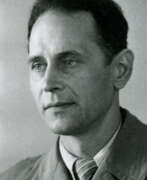

Vladislav Leopoldovich Anisovich (Russian: Владислав Леопольдович Анисович) was a Soviet artist of the mid-twentieth century. He is known as a painter, graphic artist and teacher, a representative of the Leningrad school of painting.
Vladislav Anisovich participated in various exhibitions since 1935. His work included portraits, historical and genre compositions, as well as landscapes. Among the famous paintings of the artist are "The passage of K. Voroshilov's detachment from Lugansk to Tsaritsyn", "Assault on Perekop" and others. The master taught at the Leningrad Institute of Painting, Sculpture and Architecture.
His works are in various museums and private collections in many countries, including the State Russian Museum.
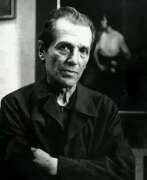

Piotr Petrovich Belousov (Russian: Пётр Петро́вич Белоу́сов) was a distinguished Soviet and Russian artist, born on May 3, 1912, in Berdyansk, and passed away on March 31, 1989, in Leningrad. He is widely celebrated for his contributions to the Leningrad School of Painting, having been an influential figure in shaping the artistic landscape of the region. His expertise extended across various mediums, including painting, etching, and graphic arts, with a notable focus on themes like the Bolshevik Revolution and historical Soviet figures like Lenin.
Belousov's educational and professional journey was deeply intertwined with the prestigious Ilya Repin Leningrad Institute of Painting, Sculpture and Architecture, where he both studied and later taught, eventually rising to the rank of professor and head of the drawing department by 1956. His career was marked by numerous accolades, including the titles of Honored Artist and People's Artist of the RSFSR, reflecting his significant impact on Russian art and education.
Throughout his life, Belousov participated in many exhibitions and his works are held in high esteem, not only in Russian state museums like the Russian Museum and the Tretyakov Gallery but also internationally. His pieces, particularly those that capture key moments in Soviet history and urban landscapes, remain influential and are sought after by collectors around the worl.
For enthusiasts of Soviet art and collectors interested in Belousov's works, staying updated on exhibitions and sales can provide valuable opportunities to acquire his art. To receive alerts about new product sales and auction events featuring Piotr Petrovich Belousov's works, signing up for updates is highly recommended.
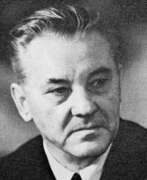

Georgy Nikolaevich Bibikov (Russian: Георгий Николаевич Бибиков) was a Russian and Soviet artist of the mid-20th century. He is known as a painter, graphic artist, illustrator, muralist and theater artist of the Leningrad school, working in the genres of landscape, portrait, still life and thematic painting.
Georgy Bibikov began participating in art exhibitions in 1920. Among his famous works are "Loaders", "Young Red Fleets Receive Uniforms", "Greetings to the Winners", "Trench Truth" and others. His works are in the State Russian Museum and in museums and private collections in Russia, Ukraine, Germany and France.


József Boksay (Russian: Иосиф Иосифович Бокшай) was a prominent Hungarian landscape painter and graphic artist, born on October 2, 1891, in Gyertyánliget and passing away on October 19, 1975, in Ungvár. His work significantly contributed to the artistic life of Carpathian Ruthenia, making him a notable figure in the Carpathian school of painting. Graduating from the Hungarian Academy of Fine Arts in 1914, where Imre Révész was his master, Boksay embarked on a journey of teaching and creating. His post-graduation life saw him taking study trips across European cities such as Vienna, Paris, and Budapest, further enriching his artistic vision.
Boksay's dedication to the arts led him to co-found a free school with Béla Erdélyi in 1927, aiming to nurture the region's artistic talent. His academic contributions continued post-World War II, teaching at the Fine Arts College in Ungvár and the Industrial Art School in Lemberg (now Lviv). A significant portion of his works delves into religious themes, a testament to his deep engagement with ecclesiastical art. This involvement is vividly illustrated by his transformative work on the ceiling frescoes of the Máriapócs church, where he meticulously integrated baroque elements with his distinctive style.
His legacy is preserved not only in his contributions to Carpathian Ruthenia's art scene but also in the numerous awards he received for his work. Today, his creations can be found in the museums of Carpathian Ruthenia and the Tretyakov Gallery, showcasing his lasting influence on the region's cultural heritage.
For collectors and art enthusiasts interested in the unique blend of cultural and artistic expressions that define Carpathian Ruthenia, Boksay's work offers a captivating exploration. His contributions to ecclesiastical and landscape painting underscore the rich tapestry of this region's art history. Sign up for updates to stay informed about new product sales and auction events related to József Boksay, ensuring you never miss an opportunity to engage with the legacy of this distinguished artist.
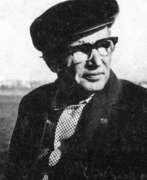

Nikolay Stepanovich Borovsky (Russian: Николай Степанович Боровский) was a Soviet Ukrainian artist of the second half of the twentieth century. He is known as a painter and teacher.
Nikolay Borovsky became famous for his portraits, landscapes and still lifes, as well as genre paintings. Some of his works were characterized by extraordinary realism. Since the early 1960s, he actively exhibited his works and in 1964 joined the Union of Artists of the USSR. For his painting "Worker. Year 1928" he received the prize of the Union of Artists of the Ukrainian SSR.
The master created a significant number of works that are in private and public collections, including a gallery of portraits of participants in the defense and liberation of Dnepropetrovsk.
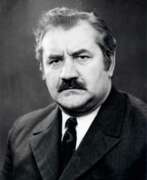

Nikolai Yakovlevich Bout (Russian: Николай Яковлевич Бут) was a Soviet artist of the second half of the twentieth century. He is known as a painter and graphic artist, a master of the battle genre.
Nikolai Bout began painting from his teenage years and immediately showed an interest in depicting historical battles. Throughout his career as a professional artist, he lived in Moscow, and spent the summer months in Kerch, where the subjects of many of his paintings originated. He painted portraits, battle and genre paintings, and landscapes. His works include the cycle "Adzhimushkay. 1942", series of paintings "Slovak National Uprising", "Heroic Marines" and other works.
Bout was an artist of the M. B. Grekov Studio of Military Artists since 1958.
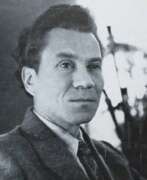

Mikhail Mikhailovich Bozhiy (Russian: Михаил Михайлович Божий) was a Soviet-Ukrainian painter, born in 1911 in Nikolaev (now Mykolaiv), Ukraine. Throughout his career, Bozhiy specialized in portraits and genre paintings, with his education grounded in the Nikolaev Art Technikum from 1930 to 1933. He began exhibiting his work in 1937, showcasing his talent in various prestigious shows, including the All-Union Art Exhibitions in Moscow during the early 1950s. His notable works, celebrated for their portrayal of Soviet citizens and landscapes, include "Svetlana Shipunova, an Outstanding Student" (1950), "A Nurse" (1955), and "My Thoughts" (1959-60), all of which are housed in the Kyiv Museum of Ukrainian Art. His contributions to Soviet art were recognized when he became a Soviet academician in 1958 and was later honored with the title of People's Artist of the USSR in 1963.
Bozhiy's life and work were deeply intertwined with the cultural and political milieu of his time. His early years were spent in Mykolaiv, but by 1936, he had moved to Odessa with his wife, where he worked as an animator at a film studio before returning to painting. His experiences during the Great Patriotic War, including creating war posters and satirical drawings, significantly influenced his artistic output. Despite health issues preventing him from serving at the front, his commitment to the war effort through his art was unwavering. Bozhiy's art is characterized by its expressive brushwork and the ability to capture the essence of his subjects, often reflecting the social and political context of the USSR.
For collectors and experts in art and antiques, Bozhiy's work offers a unique insight into Soviet-Ukrainian culture and history, highlighting the role of art in reflecting and shaping societal values. His pieces, especially those in the Kyiv Museum of Ukrainian Art, serve as a testament to his skill in portraiture and genre painting, as well as his dedication to depicting the life and people of the USSR.
For updates on new product sales and auction events related to Mikhail Mikhailovich Bozhiy, sign up now. This subscription ensures you stay informed about opportunities to acquire works by this distinguished artist and learn more about his contribution to Soviet-Ukrainian art.
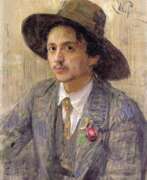

Isaak Israelievich Brodsky (Russian: Исаак Израилевич Бродский), a distinguished Russian artist, was renowned for his contributions to painting and teaching. Born in Sofievka, Russian Empire, Brodsky's artistic journey led him to become a pivotal figure in the Soviet art scene, primarily recognized for his realistic portraits and social realist works. His dedication to capturing the essence of his subjects, combined with a unique sensitivity to color and form, allowed his art to transcend mere representation, offering insights into the culture and political climate of his time.
Throughout his career, Brodsky was closely associated with significant cultural and political developments in Soviet Russia, becoming an official artist of the Soviet regime. His works, such as the iconic portraits of Lenin and other political figures, not only exemplify his skill but also serve as historical documents, offering a glimpse into the era's social fabric. His commitment to realism and the portrayal of Soviet ideals earned him a prominent place in the art world, influencing generations of artists through his role as a teacher and mentor at the Repin Institute of Arts.
Brodsky's legacy is preserved in numerous museums and galleries, with his masterpieces forming an integral part of Russia's cultural heritage. His ability to intertwine art with historical narrative has made his work a subject of study for art collectors and experts alike. For those intrigued by the depth and historical significance of Soviet art, Brodsky's oeuvre offers a fascinating exploration into the power of visual storytelling.
For collectors and experts keen on delving deeper into the rich tapestry of Russian art, staying informed about Isaac Israelievich Brodsky's work is essential. Signing up for updates ensures exclusive access to news on product sales and auction events dedicated to Brodsky's art, providing a unique opportunity to engage with the history and culture he so vividly depicted. Join us in celebrating the legacy of a true maestro of painting, whose works continue to inspire and captivate audiences worldwide.
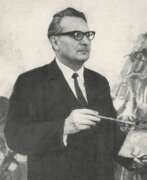

Alexander Gavrilovich Budnikov (Russian: Александр Гаврилович Будников) was a Soviet Ukrainian artist of the twentieth century. He is known as a battle painter.
During the Great Patriotic War Alexander Budnikov worked for a frontline newspaper, created posters and sketches from the battlefields. After the war he studied at the Kiev Art Institute, later became a teacher and professor at this institution. The artist worked in the genre of battle painting, and was also the author of a series of landscapes from different countries. His works are kept in museums in Ukraine, Russia and in private collections in Europe, the USA and Canada.
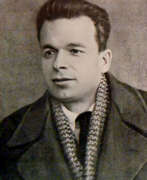

Ivan Ivanovich Cherinko (Rusian: Иван Иванович Черинько) was a Soviet Ukrainian artist who moved to Turkmenistan, after visiting Ashgabat in 1933 and finding the city beautiful and picturesque. He was among the Russian-trained artists who came to Turkmenistan and created works of art the captured the nature and culture of the republic. He founded the Union of Artists of Turkmenistan in the 1930s and co-founded the Sh. Rustaveli Turkmen Art School. In 1945, he was named an Honored Art Worker of the Turkmen Soviet Socialist Republic (Turkmen SSR, 1925–1991).


Leonid Ivanovich Chernov (Russian: Леонид Иванович Чернов) was a Soviet Ukrainian artist of the second half of the twentieth century. He is known as a painter, graphic artist and teacher.
Leonid Chernov created in various genres, including landscape, still life and genre painting. He has participated in numerous exhibitions since 1945. His work was inspired by business trips to India, Afghanistan, Bulgaria and Cuba. Notable works include cycles of landscapes "Across Ukraine", etchings "In Folk Bulgaria", drawings dedicated to Ukrainian folk songs and poems by Soviet poets.
Chernov nurtured a galaxy of Ukrainian artists and played an important role in the development of the Ukrainian art community.
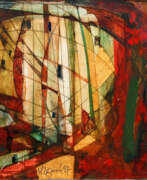

Ivan Ivanovich Chorny (Russian: Иван Иванович Чёрный) was a Soviet, Ukrainian and Russian artist of the second half of the twentieth and early twenty-first centuries. He was known for his monumental and decorative works in the style of socialist realism.
Ivan Chorny reoriented his style in the late 1990s, inventing a new technique and moving away from figurativeness in favor of abstract painting. His enigmatic compositions became an expressive expression of inner feelings enriched with colors and lines.
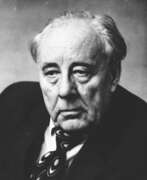

Mykhailo Hordiiovych Derehus (Russian: Михаил Гордеевич Дерегус) was a prominent Soviet Ukrainian graphic artist, painter, and educator, renowned for his significant contributions to the visual arts in Ukraine. Born on December 5, 1904, in Veseloye, Kharkiv Oblast, Derehus' artistic journey began at the Kharkiv Art Institute, where he not only honed his skills but also later imparted knowledge as a lecturer. His diverse body of work spans thematic painting, landscapes, still lifes, portraiture, etching, and book illustration, demonstrating his versatility across different mediums.
Derehus' art, particularly his expressionist lithographs, played a crucial role in illustrating significant Ukrainian literary works, such as Ivan Kotliarevsky's "Eneïda" and the writings of Nikolai Gogol, Lesya Ukrainka, Marko Vovchok, and Natan Rybak. His illustrations are celebrated for their depth and ability to capture the essence of the Ukrainian spirit. A testament to his mastery and significant impact on Ukrainian art, Derehus was awarded the prestigious Shevchenko National Prize in 1969. His legacy includes his leadership as Chairman of the National Union of Artists of Ukraine from 1955 to 1962 and his works being held in esteemed collections such as the Kuindzhi Art Museum in Mariupol, Ukraine.
For collectors and experts in art and antiques, Derehus' work represents a vital link in the chain of Ukrainian cultural heritage, offering unique insights into the nation's artistic evolution. His contributions have not only enriched Ukrainian visual arts but also ensured that the beauty of Ukraine's landscapes, its historical narratives, and the richness of its folklore continue to inspire future generations.
If you're intrigued by the artistic legacy of Mykhailo Derehus and wish to explore more about his works and their significance in the realm of Ukrainian art, consider signing up for updates. This subscription will keep you informed about new product sales and auction events related to Derehus, offering exclusive opportunities to connect with the rich tapestry of Ukrainian cultural expression.
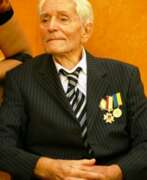

Albin Stanislavovich Gavdzinsky (Russian: Альбин Станиславович Гавдзинский) was a Soviet and Ukrainian artist of the second half of the twentieth and early twenty-first centuries. He is known as a painter, famous for his landscapes, genre paintings and portraits.
Albin Gavdzinsky in the early 1950s held his first solo exhibitions in Odessa, Kiev and Kharkov and showed his bright artistic personality. The artist was distinguished by his outstanding efficiency and precision in depiction, which was evident in his clear forms and bright colors. In 1961 he was recognized as Honorary Citizen of the city of Novaya Kakhovka, and his works (237 canvases) served as the basis for the creation of the city's art gallery, which in 2003 was named after him.


Herman Moiseyevich Gold (Russian: Герман Моисеевич Гольд) is a Soviet, Ukrainian and contemporary Israeli artist. He is known as a painter, draftsman, and watercolorist, renowned for his expressive style of painting.
Herman Gold is skilled in both oil painting and watercolor, and often gives his works a dramatic character. He is one of the few contemporary Jewish artists to be included in the legendary World Encyclopedia of Artists of All Time.
His works are in museums and galleries in many countries, including Russia, Ukraine, France, Greece, the United States and others.
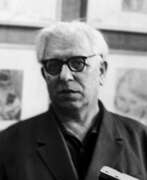

Vladimir Alexandrovich Gorb (Russian: Влади́мир Алекса́ндрович Го́рб) was a Soviet Russian artist, renowned for his versatile talents in painting, graphic design, and art education. Born on December 31, 1903, in Odessa, Russian Empire, Gorb carved a niche for himself in the Leningrad art scene, contributing extensively to its richness and diversity.
Gorb's education at the Leningrad VKHUTEIN under influential teachers like Alexander Savinov and Kuzma Petrov-Vodkin equipped him with a formidable artistic foundation, which he expanded upon throughout his career. His works, characterized by their vivid portrayal of everyday life and the natural world, were regularly featured in prominent exhibitions from as early as 1925.
Over the years, Gorb became a significant figure in the Soviet art community, not only through his artwork but also through his role as a professor at the Repin Institute of Arts. His commitment to art education shaped many future artists. His works are notable for their depth and complexity, encapsulating the Soviet ethos with a unique blend of realism and personal expression.
For those interested in exploring the works of Vladimir Gorb further or acquiring pieces for their collections, more information is available through dedicated art galleries and historical art resources online. For updates on exhibitions and available works of Vladimir Gorb, you can subscribe to our newsletter, ensuring you're informed about new sales and auction events related to this distinguished artist.
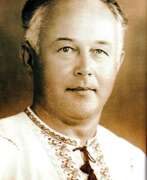

Pavel Matveyevich Gorobets (Russian: Павел Матвеевич Горобец) was a Soviet Ukrainian artist of the mid-twentieth century. He is known as a painter, landscape painter who worked early in his career as an artist-journalist.
Pavel Gorobets became famous for the lyrical style of his landscapes depicting the nature of Poltava region. His works are characterized by subtle lyricism, penetration and deep affection for his native nature. Critics called the artist a "master of landscape miniature". His works are in museums of various Ukrainian and Russian cities, as well as in private collections.
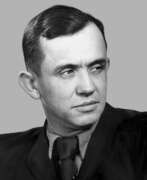

Sergey Alekseyevich Grigoryev (Russian: Сергей Алексеевич Григорьев) was a distinguished Soviet and Ukrainian artist, born in 1910 in Lugansk, Ukraine. With a rich educational background from the Zaporozhe Arts and Crafts School, Moscow VKHUTEMAS, to the Kiev Art Institute, Grigoryev's journey in the arts began early and was marked by significant achievements and contributions. He became a beacon of Socialist Realism, earning accolades such as the Stalin Prizes in 1950 and 1951, and the prestigious title of People's Artist of the USSR in 1974.
Grigoryev's work spans a variety of genres, including genre art, portraiture, and educational pieces that delve into themes of family, Soviet life, and the nurturing of young minds. His art is celebrated for its attention to detail, the vibrancy of national characteristics, and an unwavering commitment to depicting the truthfulness of life. Among his notable works are "Admission into the Komsomol" and "The Goalkeeper," housed in the Tretyakov Gallery, which exemplify his masterful portrayal of everyday life and the human condition.
His paintings, like "Nuvole estive" and "Bambina che disegna," have found places in esteemed auctions, reflecting the enduring value and appeal of his work to collectors and art enthusiasts. As an educator and a member of the USSR Academy of Arts, Grigoryev's legacy extends beyond his canvas, influencing generations of artists and shaping the landscape of Soviet and Ukrainian art.
For collectors and experts in art and antiques, the work of Sergey Alekseyevich Grigoryev offers a window into the soul of a period rich with history and transformation. His oeuvre represents not only the pinnacle of artistic achievement under the banner of Socialist Realism but also a deeply personal exploration of the human experience. To stay updated on sales and auction events featuring Grigoryev's work, signing up for updates is a step towards owning a piece of this historic tapestry.
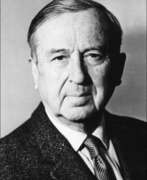

Mykola Petrovich Hlushchenko, a prominent Ukrainian post-impressionist painter, was born in 1901 in Novomoskovsk, Russia, and is celebrated for his diverse artistic contributions that span across various European landscapes, still life, nudes, and notable portraits. His early exposure to art in Yuzivka (now Donetsk), and further education at the Academy of Art in Berlin in 1924, laid the foundation for his illustrious career. Hlushchenko's work caught the attention of French critics soon after he moved to Paris in 1925, marking his transition from the New Objectivity style to post-Impressionism.
Hlushchenko's involvement with the Association of Independent Ukrainian Artists in the early 1930s, and his exhibitions across major European cities and the United States, underscored his role as a leading figure in Ukrainian post-impressionism. His work was characterized by vibrant color use and a unique blend of styles influenced by his time in Germany, France, and later in the Soviet Union. Throughout his life, Hlushchenko's art reflected his extensive travels and deep appreciation for landscapes, earning him numerous awards including the Shevchenko National Prize in 1972.
For art collectors and enthusiasts, Hlushchenko's pieces not only represent the zenith of Ukrainian post-impressionism but also embody the artist's rich, multifaceted life experiences. His paintings, such as the portraits of Oleksandr Dovzhenko and Volodymyr Vynnychenko, along with commissioned works for the Soviet government, showcase his adaptability and mastery over his medium.
To stay informed on Mykola Petrovich Hlushchenko's works and related auction events, signing up for updates is advisable. This subscription ensures you're always in the loop for new sales and exhibitions, enriching your collection with the vibrant legacy of a distinguished Ukrainian artist.
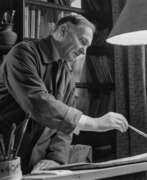

Aminadav Moiseyevich Kanevsky (Russian: Аминадав Моисеевич Каневский) was a Russian graphic artist and illustrator, celebrated for his satirical works and contributions to children's literature. Born into a large family in Elisavetgrad, Kherson province (now Kropyvnytskyi), Ukraine, in 1898, Kanevsky's early life was marked by poverty, prompting him to work from a young age in various capacities, including as a photographer's assistant and factory worker. His talent in art led him to Moscow's VKHUTEMAS, where under the guidance of Dmitry Moor, he honed his skills in cartooning and illustration, eventually becoming a prominent figure in Soviet satirical and children's publications.
Kanevsky's notable contributions include the creation of the iconic character Murzilka for children's literature, and his illustrations for "The Golden Key" by Alexei Tolstoy and "Moidodyr" by Korney Chukovsky. His work extended beyond books to satirical magazines and posters, where he depicted political themes and everyday Soviet life with humor and insight. During the Great Patriotic War, he produced anti-Nazi propaganda, showcasing his commitment to the Soviet cause through art.
Kanevsky's legacy is preserved in the State Tretyakov Gallery, the State Russian Museum, and other prestigious collections, affirming his enduring impact on Russian cultural and artistic heritage. His artworks, often executed in ink or watercolor, continue to attract collectors, with auction prices reflecting the significant interest in his oeuvre.
For enthusiasts and collectors of Aminadav Kanevsky's work, signing up for updates can provide valuable information on new sales and auction events related to his creations. This ensures that aficionados do not miss out on the opportunity to acquire pieces by this remarkable artist, whose work spans the humorous to the historically significant.
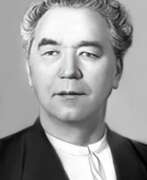

Vasyl Illich Kasiyan (Russian: Василий Ильич Касиян) Vasyl Illich Kasiyan was a Ukrainian artist and graphic designer, celebrated for his contributions to Soviet and Ukrainian visual arts. Born on January 1, 1896, in Mykulyntsi, then part of Austria-Hungary, and passing on June 26, 1976, in Kyiv, Ukrainian SSR, Kasiyan's journey through art was marked by his distinct influence on Soviet-era visual narratives. A World War I veteran, he further honed his artistic skills at the Academy of Fine Arts in Prague in the 1920s under the mentorship of Czech painter Max Švabinský.
Kasiyan's body of work spans various mediums, reflecting the ethos of his times with a deep focus on people, their struggles, and the landscapes they inhabit. Notably, his artworks such as "Portrait of a Young Woman" (1950), "Taras Shevchenko" (1945), and "My Mother" (1940) underscore his mastery in capturing the essence of his subjects, rendering them with an emotional depth that speaks volumes about his connection to the cultural and political landscape of the Soviet Union.
His contributions were widely recognized, earning him titles like the People's Artist of the Soviet Union and the Shevchenko National Prize in 1964, affirming his status as a pivotal figure in Soviet and Ukrainian art. Kasiyan's legacy is not just in the beauty of his works but also in his role as an educator and influencer in the art community, contributing significantly to the National Academy of Visual Arts and Architecture and the Kharkiv Institute of Arts.
For collectors and experts in art and antiques, Vasyl Illich Kasiyan's works represent not only aesthetic beauty but also a historical narrative of the Soviet and Ukrainian people's resilience and spirit. His pieces, found in museums and galleries worldwide, continue to inspire and provoke thought, offering a window into the artist's profound connection with his heritage.
To stay updated on exhibitions and sales featuring Vasyl Illich Kasiyan's art, sign up for our newsletter. This subscription ensures you're the first to know about new discoveries, auction events, and exclusive sales related to this esteemed artist's works.
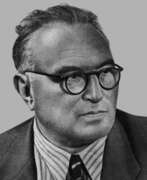

Yevgeny Adolfovich Kibrik (Russian: Евгений Адольфович Кибрик) was a prominent Soviet artist and illustrator, whose career spanned from the early 20th century until his death in 1978. Born into the turmoil of pre-revolutionary Russia, Kibrik developed a unique artistic voice that resonated with the cultural and political landscapes of his time. His early engagement with the analytical art movement, spearheaded by Pavel Filonov, significantly influenced his illustrative style. This can be seen in his illustrations for "Lieutenant Kizhe" by Tynyanov, where he first began to make a name for himself.
Kibrik's work is notable for its dynamic and expressive approach, often characterized by bold gestures and a vibrant use of color and form. This approach became particularly evident in his later works, such as the illustrations for "Colas Breugnon" by Romain Rolland, where he depicted full-bodied, epic characters with open, theatrical gestures (Arthive). His contribution to Soviet art was not just limited to his creations but extended to his role as an educator, shaping the next generation of Soviet artists through his long tenure as a professor at the Moscow state art Institute.
Kibrik's artistic legacy is preserved in various museum collections, including the State Tretyakov Gallery, the State Russian Museum, and the Pushkin State Museum of Fine Arts. His hometown of Voznesensk further honors his contributions with the Art Museum named after E. A. Kibrik, showcasing his vast body of work and continuing influence on Russian art.
For those intrigued by the evolution of Soviet art and the role of literature in shaping visual culture, Kibrik's work offers a fascinating study. His ability to weave narrative, emotion, and political commentary into his illustrations marks him as a key figure in the exploration of Soviet aesthetic and ideological expressions.
To stay updated on exhibitions and sales related to Yevgeny Adolfovich Kibrik's work, consider signing up for updates. This subscription will keep you informed about new product sales and auction events directly connected to his artistic legacy.
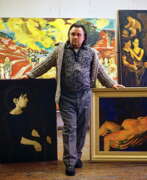

Alexander Mikhailovich Kishchenko (Russian: Александр Михайлович Кищенко) was a Soviet and Belarusian artist of the second half of the twentieth century. He is best known as a muralist painter.
Alexander Kishchenko is considered one of the most famous artists of Belarus of the 20th century, and his works are valuable assets of Belarusian culture. He worked in all genres of easel and monumental decorative painting and created hundreds of works during his career, including philosophical paintings and portraits. The artist was also proficient in mosaics, ceramics and tapestry.
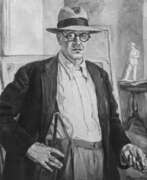

Pyotr Konchalovsky (Russian: Пётр Петрович Кончаловский) was a renowned Russian painter, a prominent member of the Jack of Diamonds group, which sought to blend modern French and German art with Russian primitivism. Born into an artistic family, Konchalovsky's career spanned several decades, during which he became known for his extensive use of color and innovative approach to composition. Influenced by Paul Cézanne, his works demonstrate a complex evolution of styles, from impressionism to socialist realism, without fully embracing abstraction. Konchalovsky's repertoire includes over five thousand works, comprising still lifes, landscapes, and portraits that contributed significantly to the development of Soviet realistic art. Notably, his artistry extended beyond his canvas; his family legacy includes notable figures in the arts, contributing to his lasting impact on both Russian and global art scenes.
His significant contribution to the avant-garde movement and his distinctive style, blending Fauvism and Cubism with realism, positioned him as a key figure in pre-Soviet and Soviet art. Despite challenges, including initial rejection in his homeland and a complex relationship with the Soviet regime, Konchalovsky's work received acclaim, including exhibitions at the prestigious Tretyakov Gallery. His legacy is preserved through the Petr Konchalovsky Foundation, ensuring his vibrant and dynamic works continue to inspire.
For collectors and experts in art and antiques, Konchalovsky's work offers a unique window into the evolution of Russian art during a turbulent century. His ability to synthesize various artistic influences while maintaining a distinctive voice makes his work a valuable addition to any collection.
To stay updated on sales and auction events related to Pyotr Konchalovsky's art, sign up for our newsletter. This subscription ensures you're informed about new opportunities to acquire pieces by this remarkable artist.
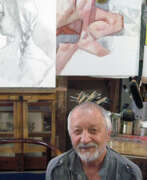

Vitaly Nikolayevich Kulikov (Russian: Виталий Николаевич Куликов) was a Soviet and Ukrainian artist of the last third of the twentieth and early twenty-first centuries. He is known as a painter, graphic artist, book designer, poster artist, as well as a teacher, who brought up several generations of artists and architects over 40 years of teaching.
Vitaly Kulikov worked in various genres, including portraiture, landscape and still life, as well as successfully engaged in graphics and design. He, according to critics, refracted the traditions of avant-garde art of the early 20th century, combining them with a philosophical outlook and sharp plastic execution.
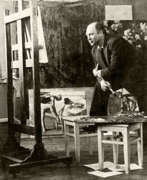

Konstantin Matveyevich Lomykin (Russian: Константин Матвеевич Ломыкин) was a Soviet and Ukrainian artist of the second half of the twentieth and early twenty-first centuries. He is known as a painter and graphic artist, People's Artist of the Ukrainian SSR.
Since 1951 Konstantin Lomykin actively participated in various exhibitions both in the USSR and abroad. His work covers a variety of genres, including thematic painting, portrait, landscape and still life. One of his most famous works was the painting "Bogdan Khmelnitsky's Oath over the Body of a Tortured Cossack", presented at the Republican Exhibition in 1954.
Lomykin's works can be found in art museums in Ukraine, as well as in private collections in various countries, including Japan, France, Greece, Germany, Italy and Portugal.
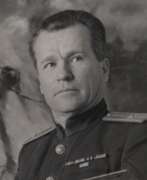

Pyotr Tarasovych Maltsev (Russian: Пётр Тарасович Мальцев) was a distinguished Soviet artist, celebrated for his mastery in socialist realism. Born on December 17, 1907, in Mariupol, Maltsev carved a niche for himself in the art world through his profound works that often depicted the valor and spirit of the Soviet people during significant historical events. His art education was rooted in the traditions of the Zaporozhe Art School and further honed at the VKhUTEIN, under the guidance of notable Soviet artists such as P.V. Kuznetsov and V.A. Favorsky.
Maltsev's oeuvre includes a plethora of works ranging from paintings and posters to monumental dioramas, with notable pieces like “The Storm of Sapun Ridge,” which vividly captures the intensity of the Battle of Sevastopol. His art, imbued with the ethos of socialist realism, strives to embody the heroism and resilience of the Soviet populace amidst the trials of war and the pursuit of socialism.
His contributions to Soviet art were not only recognized by his contemporaries but continue to be revered today, with many of his works being housed in prestigious institutions such as the State Tretyakov Gallery and the Central Naval Museum. Maltsev's legacy extends beyond the canvas, encapsulating the spirit of an era and continuing to inspire generations. His passing on October 5, 1993, marked the end of a remarkable chapter in Soviet art history, but his works live on, offering a window into the Soviet soul and its indomitable will.
For collectors and experts in art and antiques, Maltsev's body of work presents a unique insight into the Soviet aesthetic and ideological landscape. To stay updated on new product sales and auction events related to Pyotr Tarasovych Maltsev, subscribing for updates is highly recommended. This subscription ensures that enthusiasts are well-informed of the latest developments and opportunities to engage with Maltsev's enduring legacy.

Victor Mikhailovich Malyi (Russian: Виктор Михайлович Малый) is a Soviet and contemporary Russian artist. He is known as a painter and teacher, Honored Art Worker of Russia.
Victor Malyi as a painter specializes in the genres of landscape and still life. His artistic career began with a major exhibition "Soviet South" in 1967. For his contribution to art, he was awarded many certificates, diplomas and badges of honor from various organizations and departments.
His works are in museums, private collections and galleries both in Russia and abroad. Since 1976, he has also taught painting at the Surikov Moscow State Academic Art Institute and is a professor at this institution.


Gavriil Kondratyevich Malysh (Russian: Гавриил Кондратьевич Малыш) was a Soviet and Russian artist of the second half of the twentieth century. He is known as a painter and watercolorist, a representative of the Leningrad school.
Gavriil Malysh worked mainly in the genres of landscape, still life and genre compositions. He became famous as a bright watercolorist, a master of lyrical landscape and decorative still life. His works are distinguished by a color palette dominated by blue, lilac and violet tonalities. His works are in numerous museums and private collections in Russia and other countries, including France, USA, Japan and Italy.
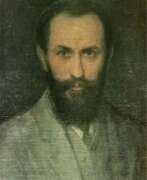

Anton Ivanovich Manastyrsky (Russian: Антон Иванович Манастырский) was a Ukrainian and Soviet artist of the twentieth century. He is known as a painter and graphic artist.
Anton Manastyrsky became famous for his genre paintings based on Ukrainian folk songs. His works are characterized by plasticity, rhythm and poetry. He also worked in the portrait genre, creating such canvases as "Portrait of Mother", "Portrait of Taras Shevchenko" and others. The master also illustrated books and worked in the religious genre, restoring the iconostasis in the Church of the Assumption of the Blessed Virgin Mary in Ancient Galich.
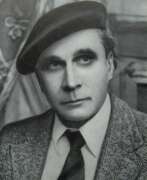

Vitold Antonovich Manastyrsky (Russian: Витольд Антонович Манастырский) was a Ukrainian and Soviet artist of the second half of the twentieth century. He is known as a painter, graphic artist, teacher, and son of the artist Anton Manastyrsky.
Vitold Manastyrsky created many works, including genre paintings, portraits, landscapes and still lifes. In his works he reflected the beauty of the Pre-Carpathian region, the life of its inhabitants, as well as portrayed his contemporaries - workers, peasants and cultural figures. He was active both creatively and in public and pedagogical spheres, he was often elected to the governing bodies of the Union of Artists of Ukraine. Many of his works are exhibited in Ukrainian museums and galleries.
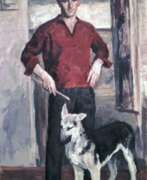

Leonid Yakovlevich Mezheritski (Russian: Леонид Яковлевич Межерицкий) was a Soviet, Ukrainian and Israeli artist of the second half of the twentieth and early twenty-first centuries. He is known as a painter who specialized in oil painting, a representative of the South Russian (Odessa) school.
Leonid Mezheritski created mainly plein air landscapes, and also worked in the genres of portraiture and still life. His style was based on the coloristic systems of French Impressionism and Post-Impressionism. His works can be found in state art museums in Ukraine and private collections in various countries, including the United States, Canada, Germany, England, Israel and Russia.
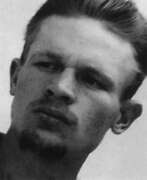

Georgy Moiseevich Moroz (Russian: Георгий Моисеевич Мороз) was a Soviet and Russian artist of the second half of the twentieth and early twenty-first centuries. He is known as a painter, a representative of the Leningrad school, whose work included landscapes, still lifes, genre compositions and portraits.
Georgy Moroz, having started participating in exhibitions since 1963, traveled extensively throughout the USSR and foreign countries, including Italy, the USA and Japan. His works are in museums and private collections in Russia, Japan, Italy, Germany, Holland, France, Sweden, USA and other countries.
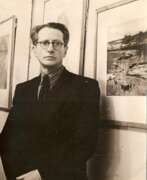

Samuil Grigorievich Nevelshtein (Russian: Самуил Григорьевич Невельштейн) was a distinguished Soviet Russian painter, watercolorist, graphic artist, and art teacher, known for his impactful role in the Leningrad school of painting. Born on March 22, 1903, in Kherson, Ukraine, then part of the Russian Empire, Nevelshtein made a significant mark in the art world with his expressive portraits and scenes reflecting Soviet life.
Nevelshtein's journey in the arts began at VKhuTeMas, a renowned Moscow art school, where he honed his skills before moving to Leningrad. There, he graduated from the Proletarian Institute of Fine Arts and became a pivotal member of the Leningrad Union of Artists from 1935. His artwork primarily includes portraits, genre compositions, and landscapes, showcasing his mastery in both watercolors and oil painting.
His works are held in high esteem and are part of collections in major museums and private collections across the globe, including the State Russian Museum. Nevelshtein's exhibitions were well-received, contributing significantly to the cultural tapestry of Leningrad, now Saint Petersburg, until his death on November 16, 1983.
For those interested in exploring the works of Samuil Nevelshtein or learning about upcoming auctions and exhibitions featuring his art, consider subscribing for updates. This will ensure you are informed about new sales and auction events related to Nevelshtein's works, enhancing your collection and knowledge of this influential artist.
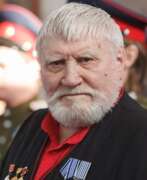

Pyotr Pavlovich Ossovsky (Russian: Пётр Павлович Оссовский) was a Russian artist, born in 1925, whose work deeply resonates with the spirit and challenges of his time. Known for his versatility, Ossovsky excelled in genre and portrait painting, as well as graphic arts, making significant contributions to the Soviet art scene from the 1960s onwards.
Ossovsky's artwork was steeped in the realities of Soviet life, often exploring themes of provincial Russia and the everyday lives of its people. His approach was not just observational but also deeply personal, reflecting his own experiences and the broader cultural environment. He was particularly noted for incorporating themes from various regions, including Cuba, Mexico, and Siberia, into his series of paintings which later culminated in exhibitions.
A significant part of Ossovsky’s legacy is his academic contributions; he was a member of the USSR Union of Artists and an academician of the Russian Academy of Arts from 2005. His works are held in high regard and continue to be exhibited posthumously, highlighting their lasting impact on Russian art.
For collectors and experts in Soviet art, understanding Ossovsky's work offers a window into a unique era of artistic expression. His pieces, such as "Morning in Havana" and "Portrait of a Father," are not just artistic expressions but historical documents that capture the essence of the time.
For those intrigued by Pyotr Pavlovich Ossovsky's artistic heritage and interested in exploring further opportunities related to his work, subscribing for updates is highly recommended. This subscription will keep you informed about upcoming sales, auction events, and exhibitions featuring Ossovsky's art, ensuring you never miss a chance to enrich your collection.
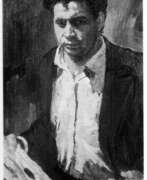

Nikolai Vasilievich Ovechkin (Russian: Николай Васильевич Овечкин) was a distinguished Soviet and Russian painter, renowned for his contributions to war art and pedagogy. Born on May 4, 1929, in Novoshakhtinsk, North Caucasus Territory, Ovechkin embarked on his artistic journey at Moscow's Central School of Industrial Art in 1945, later attending the secondary art school at the V. I. Surikov Institute, and ultimately graduating from the Moscow State Art Institute V. I. Surikov in 1961. His dedication to art education was evident through his work at Gymnasium No. 10 in Novocherkassk, where he taught drawing, and his leadership of the city's art studio established in the 1920s by M. B. Grekov.
Ovechkin's notable achievements include receiving the M. B. Grekov gold medal in 1968 for his participation in the reconstruction of F. A. Rubo's "Battle of Borodino" panorama and the USSR Academy of Arts' gold medal in 1976 for his diorama "The Battle of the Dnepr". His monumental works, such as the dioramas "The Battle of Moscow" and "The Battle of Stalingrad," showcased at the Kiev State Museum of the Great Patriotic War, highlight his mastery in capturing historical moments.
Throughout his career, Ovechkin was celebrated with numerous titles and awards, including the People's Artist of the USSR in 1985, showcasing his significant influence in Soviet and Russian art. His artworks, deeply rooted in historical and patriotic themes, continue to be valued by collectors and art enthusiasts.
For those intrigued by Nikolai Vasilievich Ovechkin's art and wish to explore more about his legacy or add a piece of his work to their collection, stay informed about new sales and auction events. Signing up for updates will ensure you don't miss out on the opportunity to own a part of this esteemed artist's history.
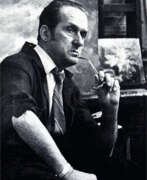

Viktor Grigorievich Puzyrkov (Russian: Виктор Григорьевич Пузырьков) was a Ukrainian artist, celebrated for his contributions to the Socialist Realism art movement. Born on October 4, 1918, in Dnipro, Ukraine, Puzyrkov's career spanned through significant historical periods, culminating in his recognition as a People's Artist of the USSR in 1979. His educational journey included studies at the Dnepropetrovsk art school, the Kiev art Institute, and further refinement of his skills in Samarkand during the evacuation of Kiev and the Moscow art institutes. Graduating in 1946, he later became a professor at the Kiev art Institute in 1957.
Puzyrkov's artistry was deeply rooted in themes of naval and maritime life, evident in his thematic paintings such as "Chernomorets" (1947), "Surf" (1952), and "After the storm" (1957), among others. His mastery in painting was recognized with several accolades, including the prestigious Shevchenko National Prize in Ukraine in 1976. His artworks, characterized by a vibrant depiction of life at sea and Soviet-era themes, have been featured in various exhibitions and auctioned, with pieces like "Staline sur la rade" (1949) attaining notable auction prices.
For art enthusiasts and collectors, Viktor Grigorievich Puzyrkov's oeuvre presents a fascinating exploration of Socialist Realism, maritime beauty, and historical depth. His works like "Black Sea Fleet," "Silence," "Immortality," "Peace Ahead," and "Yachts in the Sea" showcase his versatility and profound understanding of his subjects.
To stay informed on updates related to Viktor Grigorievich Puzyrkov, including new product sales and auction events, sign up for our newsletter. This subscription is your gateway to the world of Puzyrkov, offering exclusive insights and opportunities to acquire works by one of Ukraine's most esteemed artists.


Fyodor Pavlovich Reshetnikov (Russian: Фёдор Павлович Решетников) was a Soviet painter, celebrated for his contribution to socialist realism. Born in 1906 in what is now Ukraine, Reshetnikov grew up in a family of icon painters and, despite being orphaned at a young age, his passion for art was nurtured by his brother, who also painted church frescoes and icons. His journey in art began without formal secondary education, eventually leading him to study at the prestigious VKHUTEIN in Moscow, where he honed his skills in painting and graphics under the guidance of Sergei Gerasimov and Dmitry Moor, respectively.
Reshetnikov's early career was marked by his role as an "artistic reporter" during arctic expeditions, a period during which he developed a keen eye for realist representation. This experience, coupled with his mastery in graphic caricature, laid the foundation for his later work, which predominantly focused on the Soviet leadership and the everyday lives of ordinary citizens, especially children. His paintings like "Arrived on vacation" (1948), "Low Marks Again" (1952), and "Reexamination" (1954) are emblematic of his focus on youth and education, resonating with the spirit of the times and earning him a revered place in Soviet art history.
Throughout his career, Reshetnikov remained an ardent critic of formalism in art, aligning his work with the ideals of socialist realism. His contributions were recognized by the Soviet government, leading to prestigious awards, including the Stalin Prize, and his appointment as a vice-president of the Academy of Arts in 1974. His works are now held in Russia's most prestigious collections, including the Tretyakov Gallery and the Russian Museum.
For art collectors and experts, Reshetnikov's oeuvre represents a rich tapestry of Soviet history, imbued with a deep understanding of its culture and its people. His ability to capture the zeitgeist of his era through the lens of everyday life and political context makes his work not only historically significant but also emotionally resonant.
To stay updated on new discoveries and sales related to Fyodor Pavlovich Reshetnikov's work, signing up for updates is recommended. This ensures that enthusiasts are well-informed about auction events and product sales that celebrate the legacy of this remarkable Soviet artist.
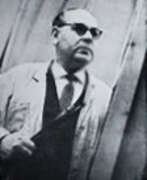

Victor Markiyanovych Savin (Russian: Виктор Маркиянович Савин) was a Ukrainian Soviet artist of the mid-twentieth century. He is known as a painter, graphic artist and teacher.
Victor Savin worked in easel painting, graphics and book illustration. He became famous for his genre paintings of Soviet themes, portraits of prominent personalities, and propaganda posters. An important part of his works are illustrations for Ukrainian fairy tales, novels and stories.
His works are in various museums and galleries in Ukraine and abroad, including the National Museum in Lviv and the Kharkiv Art Museum.
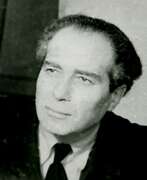

Joseph Alexandrovich Serebriany (Russian: Иосиф Александрович Серебряный) was a prominent figure in the Soviet art scene, known for his deep involvement in various artistic endeavors. Born in Horodnia, Chernigiv Province, in the Russian Empire in 1907, Serebriany showcased his talent and dedication to art from a young age. He pursued his education at several prestigious institutions, including the Poltava Studio of Art, the Leningrad College of Art and Industry, and VKhUTEIN / Institute of Proletarian Fine Arts, where he specialized in theatrical design.
Serebriany's contributions to art were vast and varied. During the challenging times of the Siege of Leningrad from 1941 to 1945, he worked as a poster designer, using his skills to bolster the spirits of those enduring the hardships of war. His commitment to education was equally noteworthy; he taught at the Ilya Repin Institute of Painting, Sculpture and Architecture for over three decades, shaping the minds of future artists. His works, characterized by realism and a focus on Soviet themes, earned him recognition as a People's Artist of the USSR in 1965, a testament to his significant impact on Soviet art.
Serebriany was also an active participant in the Leningrad Union of Artists, serving as its chairman during two periods, which highlights his leadership and influence within the artistic community. His artworks, which include a diverse range of paintings from portraits of Soviet heroes to scenes of significant historical events, are held in high esteem and form part of Russia's national art collection.
For art collectors and experts, Joseph Alexandrovich Serebriany's legacy is a fascinating exploration of Soviet-era artistry, reflecting the social and political atmosphere of his time. His contributions to art education and the portrayal of Soviet themes in his work offer rich insights into the era's artistic movements.
To stay updated on exhibitions and auctions featuring Joseph Alexandrovich Serebriany's work, signing up for updates is highly recommended. This subscription will ensure you are informed about new sales and events related to this influential artist, providing unique opportunities to engage with his impactful legacy.


Mikhail Andreevich Sharonov (Russian: Михаил Андреевич Шаронов) was a Russian, Soviet and Ukrainian artist of the first half of the twentieth century. He is known as a painter, graphic artist and teacher.
As an artist, Mikhail Sharonov worked in the genres of portrait, landscape, still life and historical genre. He was also a professor and rector of the Kiev Art Institute. An important aspect of his life was art collecting; he amassed a significant collection of etchings by the Spanish artist Goya and donated 60 sheets from this collection to the Khanenko Museum in Kiev in 1941.
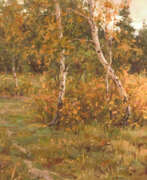

Vladimir Yakovlevich Shcherban (Russian: Владимир Яковлевич Щербань) was a Soviet and Russian artist of the second half of the twentieth and early twenty-first centuries. He is known as a painter.
Vladimir Shcherban fought on the Stalingrad front during the Great Patriotic War and received his art education at the Moscow City Art Studio for war invalids. His art was largely devoted to historical-revolutionary and military themes. The artist also made creative journeys to different regions, which inspired him to create a series of genre paintings, portraits and landscapes.


Sergei Fedorovich Shishko (Russian: Сергей Фёдорович Шишко) was a distinguished Soviet painter, renowned for his profound contributions to the landscape and still-life genres of art. Born in 1911 in the town of Nosivka, Ukraine, Shishko's early exposure to art in school laid the foundation for his lifelong passion. Despite the tumultuous backdrop of the Soviet regime, his works exhibited a distinct impressionistic flair, diverging from the state-sanctioned socialist realism of the time. His remarkable series of canvases, particularly those depicting Mariyinski Park and the Carpathian Mountains, showcase an exploratory spirit and a bold embrace of color and light, earning him acclaim far beyond the borders of his homeland.
Shishko's life was not without its trials; he navigated the complexities of Soviet politics and personal challenges with resilience, balancing his artistic endeavors with the demands of family life. His dedication was recognized through numerous awards, including the prestigious title of People's Artist of the USSR. Shishko's works, which continue to be celebrated for their vibrant depiction of Ukrainian landscapes and still lifes, reflect a deep-rooted love for his country and an unyielding commitment to artistic freedom.
His legacy extends beyond his paintings, serving as a testament to the power of art to transcend political and personal adversity. Shishko passed away in 1997, but his influence endures, with his masterpieces residing in museums and private collections worldwide, reminding us of the enduring beauty of the Ukrainian landscape and the indomitable spirit of its people.
For collectors and art enthusiasts interested in Sergei Fedorovich Shishko's work, signing up for updates can provide exclusive information on new product sales and auction events related to this remarkable artist. This subscription is a valuable resource for those keen to explore the depths of Shishko's artistic legacy and the ongoing influence of his work in the realms of art and culture.


Alexey Shovkunenko (Russian: Алексей Алексеевич Шовкуненко), an eminent Ukrainian and Soviet artist, is celebrated for his vast contributions across painting, graphic arts, and education. His birth on March 21, 1884, in Kherson, within the bounds of the then Russian Empire, and his passing on March 12, 1974, in Kiev, USSR, spanned a timeline of significant historical and artistic evolutions. Renowned for his work in modernist and socialist realism styles, Shovkunenko's repertoire includes landscapes, still lifes, and portraits, crafted through oil, watercolor, and pastel mediums.
His educational journey at the Grekov Odesa Art School and the Saint Petersburg Academy of Arts set the foundation for his illustrious career in both creation and mentorship. Shovkunenko was deeply integrated into the art community, engaging with the Society of South Russian Artists and the Kostandi Society of Artists. His academic roles, notably at the Kyiv State Art Institute, positioned him as a mentor to generations of artists.
Shovkunenko's artwork spans various themes, from the industrial to the intimate. His "Dneprostroy" series, lauded at international exhibitions, and his psychological portraits of significant Ukrainian figures, such as Pavlo Tychyna, Mykola Lysenko, and Oleksandr Bohomolets, underscore his versatility and depth. These works serve not only as artistic expressions but also as historical narratives, capturing the spirit and challenges of his times.
For aficionados of art and antiquities, Shovkunenko's legacy offers a rich tapestry of Eastern European cultural and artistic traditions. His influence, through both his pedagogical endeavors and his diverse body of work, continues to enchant and inspire.
For those keen on delving deeper into Alexey Shovkunenko's remarkable contributions and staying abreast of the latest developments related to his work, including sales and auction events, signing up for updates is highly recommended. This initiative promises to be a gateway to understanding the profound impact and enduring legacy of this distinguished artist.
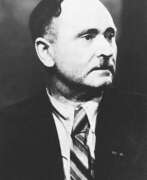

Ivan Nikolayevich Shulga (Russian: Иван Николаевич Шульга) was a Ukrainian Russian and Soviet artist of the first half of the twentieth century. He is known as a master of painting and drawing and a teacher. His name is included in the "Unified Art Rating of the world's 10,000 best artists" and in the list of the 100 most outstanding artists of Ukraine.
Ivan Shulga worked in different genres: he painted portraits, genre paintings, landscapes (marine, landscape, architectural, industrial), created still life paintings, panels, drawings for art postcards, political posters. His artistic legacy also includes pictures in the genre of nude and historical genre. The artist also illustrated magazines and books, designed theatrical sets.
Shulga worked in watercolor, pencil drawing, gouache, ink and sanguine, pastel, oil and tempera painting.
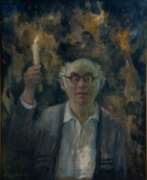

Efim Davidovich Simkin (Russian: Ефим Давидович Симкин) was a Soviet and Russian artist of the second half of the twentieth century. He is known as a portrait painter and genre painter.
Efim Simkin became famous for his psychological portraits, as well as genre paintings. The main place in his work was occupied by the theme of the Second World War, of which he was a participant. Many of his works reflect the horrors of war, death, fear, such as, for example, the paintings "Don Quixote. Horrors of War" and "Holocaust. Victims of War." At the same time, his scenes of peaceful life, according to critics, are full of beauty in the ordinary. Large canvases of the master were characterized by increased drama.
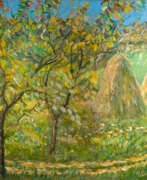

Pyotr Dorofeyevich Slyota (Russian: Пётр Дорофеевич Слёта) was a Ukrainian Soviet artist of the mid-twentieth century. He is known as a painter, famous for his thematic paintings and landscapes.
In his works, according to critics, Pyotr Slyota showed the best features of Soviet art - patriotism, humanism, love for nature. In his work an important place is occupied by works devoted to the history of Ukraine. In landscape works from different countries where the artist visited ("Street in Košice", "Charles Bridge", "Paris. Notre Dame"), he managed to reveal the national and social features of these cities.
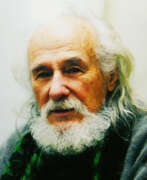

Victor Ivanovich Tolochko (Russian: Виктор Иванович Толочко) was a Soviet and Ukrainian artist of the second half of the twentieth and early twenty-first centuries. He is known as a painter, a decorated participant of the Great Patriotic War, a master of landscape, still life, battle and historical genres.
When working in the historical genre Victor Tolochko tried to live in the historical atmosphere. Working on the painting "Defenders of the Brest Fortress", he lived in the fortress for six months and created more than 50 sketches and sketches. In addition to the military theme, the master's life-affirming landscapes were also highly appreciated by critics.
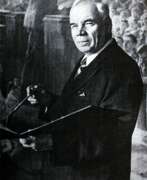

Karp Demyanovich Trokhimenko (Russian: Карп Демьянович Трохименко) was a Soviet Ukrainian painter known for his significant contributions to socialist realism. Born in 1885, Trokhimenko's works primarily depicted scenes of everyday life, socialist construction, and the natural beauty of Ukraine.
Trokhimenko's distinctive style is characterized by his detailed, realistic portrayal of his subjects, capturing the spirit and ideals of the Soviet era. He was celebrated for his ability to convey the human experience within the broader context of socialist society. His paintings often featured vibrant colors and meticulous attention to detail, making them stand out in exhibitions.
Among his notable works are "Shevchenko and Engelhardt" (1939), "Kateryna" (1959), and "May Days in Old Kyiv" (1975), all housed in the National Art Museum of Ukraine. These paintings exemplify his talent in depicting historical and rural life with a sense of warmth and authenticity. Trokhimenko's legacy continues to influence contemporary Ukrainian artists, and his works remain highly regarded in art circles.
For updates on new product sales and auction events related to Karp Demyanovich Trokhimenko, sign up for our newsletter.


Valentina Petrovna Tsvetkova (Russian: Валентина Петровна Цветкова) was a Soviet and Ukrainian artist of the second half of the twentieth and early twenty-first centuries. She is known as a painter and graphic artist, a master of landscape, still life and portraiture, who mastered various painting and drawing techniques, including oil, pastel, watercolor, acrylic, pencil and felt-tip pen.
Valentina Tsvetkova in her work focused on the diversity of forms of nature, unique features of climate, flora, architecture and the way of life of people. Her landscapes were characterized by originality and decorativeness, and portraits reflected the main features of appearance and inner essence of each depicted person. The artist painted portraits of war heroes, as well as scientists and representatives of the creative intelligentsia.
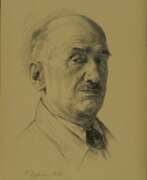

Georgy Semyonovich Vereisky (Russian: Георгий Семёнович Верейский) was a Russian and Soviet artist of the first half of the twentieth century. He is known as a painter, graphic artist, and representative of the Leningrad school of landscape painting.
Georgy Vereisky specialized in graphic portraits and landscapes, using lithography, etching and drawing. His works were characterized by accuracy in conveying the characters of models and clarity of lines. The master created many landscapes and genre compositions. He is particularly known for his series of lithographs, including portraits of Russian artists, and works dedicated to Soviet figures, pilots, workers and cultural figures.
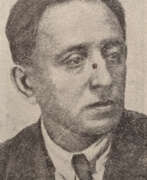

Boris Yeremeevich Vladimirsky was a Soviet artist and graphic artist. One of the most prominent representatives of socialist realism in painting.
Boris Vladimirsky belonged to the number of officially recognised artists. His paintings are diverse in subject matter - portraits of statesmen, everyday life of Soviet people, landscapes. The artist himself declared the purpose of his work "real-impressionist depiction of the life of workers and peasants".
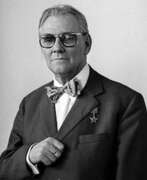

Yevgeny Viktorovich Vuchetich (Russian: Евгений Викторович Вучетич) was a Soviet sculptor and artist of significant acclaim, celebrated for his allegorical and heroic monuments, notably "The Motherland Calls," once the largest sculpture globally. Born in what is now Ukraine to a Montenegrin father and a Russian-French mother, Vuchetich's early life in Yekaterinoslav (Dnipro) set the stage for his illustrious career. His works, characterized by their grand scale and emotive power, encapsulate the spirit of Socialist Realism, earning him prestigious awards such as the Lenin Prize and Hero of Socialist Labor.
Vuchetich's contributions to Soviet monumental art are vast, including the renowned Soviet War Memorial in Treptower Park, Berlin, and the poignant "Let Us Beat Swords into Plowshares" located at the United Nations headquarters. His dedication to the military theme was not arbitrary; his volunteer service at the front during World War II profoundly influenced his artistic direction. This theme resonates through his works, immortalizing the valor and tragedy of war.
His oeuvre reflects a deep engagement with the cultural and historical milieu of his time, contributing significantly to the landscape of Soviet and global art. Among his notable works are the Treptower Park Memorial, the "Let Us Beat Swords into Plowshares" sculpture, and the iconic "The Motherland Calls," situated on Mamayev Kurgan, which stands as a testament to his legacy.
Collectors and experts in art and antiques admire Vuchetich's unique ability to merge ideological fervor with artistic mastery, making his works compelling subjects of study and appreciation. His sculptures not only capture the essence of an era marked by conflict and idealism but also continue to inspire through their aesthetic and symbolic significance.
For updates related to new product sales and auction events featuring Yevgeny Viktorovich Vuchetich's work, sign up for our newsletter. This subscription will keep you informed about opportunities to own a piece of history from one of the Soviet Union's most distinguished artists.


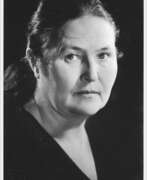

Tatyana Nylvna Yablonskaya (Russian: Татьяна Ниловна Яблонская) was a distinguished Ukrainian painter born on February 24, 1917, in Smolensk, Russian Empire, and passed away on June 17, 2005, in Kyiv, Ukraine. Her artistic journey began under the mentorship of Fedir Krychevsky at the Kyiv State Institute of Art, where she also served as a faculty member. Yablonskaya's paintings are renowned for their vibrant depiction of Ukrainian life, nature, and the spirit of its people, exemplified in works like "Bread" (1949) and "Morning" (1954).
Her commitment to art extended beyond the canvas, as Yablonskaya was a key figure in Ukraine's cultural landscape, serving as a Member of Parliament and holding significant positions within the Ukrainian and USSR Artists' Unions. Her contributions to art were recognized with numerous awards, including the prestigious title of People's Artist of the USSR, the Stalin Prize, and the Hero of Ukraine honor. Yablonskaya's legacy is preserved through her students, like Mikhail Turovsky, and her works that continue to inspire at exhibitions and in collections worldwide.
For collectors and enthusiasts of art and antiques, Yablonskaya's work offers a unique glimpse into the soul of Ukrainian culture and the resilience of its people through history. Her ability to blend traditional and modern techniques made her an influential figure in the art world.
Stay updated on Yablonskaya's work and related auction events by signing up for our newsletter. This subscription ensures you're informed about the latest sales and exhibitions featuring Yablonskaya's art, helping you stay ahead in the collectibles market.
